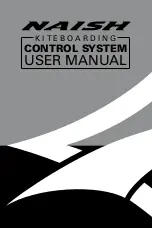
7
We recommend that you try the correct fitting of the acceleration system
on equipment designed to do this, most paragliding schools have this sort
of equipment.
2.6 INSPECTION AND WING INFLATION ON THE GROUND
Once all the equipment has been thoroughly checked and the wind
conditions are favourable, inflate your LINK as many times as necessary
in order to become acquainted with the wings behaviour. The LINK
inflates easily and smoothly. An excess of energy is not necessary and the
wing will inflate with minimum pressure on the harness when you move
forward. This may be assisted by using the A lines. Do not pull; merely
support them as they rise naturally with the movement of the wing. Once
the wing is in the 12 o’clock position, simply apply correct pressure on the
brake lines and the LINK will sit over your head.
We recommend placing the wing on the ground in a horseshoe shape
which in most conditions will facilitate a smooth and easy inflation.
2.7 TRIMMERS
Take off
Thanks to the profile of the LINK, all aspects of take off can be controlled
using the trimmers.
The SLE system pre-positions the open cells of the leading edge in
the best possible way assuring a rapid formation the wing profile. This
contribution is in itself already a huge advantage when attempting to
take off in nil wind conditions but the correct use of the trimmers at this
time with further enhance an easy take-off. In nil wind and without the
application of trimmers the LINK inflates easily and effortlessly. However
by adjusting the trimmers we can control both the inflation and the speed
at which the wing rises. We should not confuse the speed of the inflation
with the speed of the forward run required. It is important to remember
that the minimum take-off speed is achieved with the trimmers closed and
as the trimmers are opened more speed will be required.
Therefore every pilot should be aware of the trimmer settings and make
any necessary adjustments appropriate to the conditions, the terrain and
pilot ability.
In flight
The trimmers on the LINK are highly and precisely adjustable allowing
the pilot to either increase speed by opening the trimmers or conversely
decrease speed by closing them. Each trimmer is equipped with a scale
clearly numbered so allowing the pilot to easily check and confirm the
exact setting of each. Each trimmer may be set to compensate for the
torque effect of the engine allowing fine tuning to ensure the wing remains
in symmetrical flight. The pilot will very quickly become familiar with
the scale and after just a few flights be able to optimise every flight by
adjusting the trimmers to their most efficient setting.
With the trimmers closed and using just the full range of brake travel the
LINK is a precise, light to handle and a fun machine to fly.
Landing
The LINK offers the comfort of ending the flight with the perfect landing;
large areas and long runs are no longer required.
It must be remember that in wind nil conditions the forward ground speed
encountered may be significantly higher and during landing that speed
must be decreased as safely as possible. This can be achieved by fully
closing the trimmers and proportionately applying the brakes. If necessary
as the pilot reaches the ground a longer run off should also be carried out.
When landing in moderate wind conditions, the ground speed is reduced
so a simple and progressive application of the brakes will be enough for a
perfect landing.
Landing with open or half open trimmers is possible, but it will be
necessary to balance the application of the brakes to the position of the
trimmers and the forward ground speed being experienced. Of course
open trimmers and an increase in forward ground speed when landing
may require a larger landing area as opposed to when the trimmers are
closed. The LINK very efficiently transforms forward speed into lift and
inherently allows a wide margin for error either with or without wind.
Summary of Contents for LINK 23
Page 1: ...USER S MANUAL LINK...
Page 17: ...17 11 3 RISER ARRANGEMENT...
Page 18: ...18 11 4 LINE PLAN...
Page 23: ...23...






































